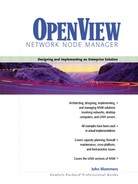Geographic Regions and Business Relationships
Geography is the most common and obvious definer for communities of interest. Campus buildings define LAN boundaries and the WAN is the point of demarcation between geographies. The community of interest is often mirrored by the organization that supports it. Multiple small remote sites may be relatively dependent, but for the purposes of defining an NNM management domain, these may be added into a larger geographic domain.
Some corporations have many, nearly autonomous sites with their own independent network staff and support organizations. Some point-to-point WAN links may exist between them as needed, and each may have an Internet connection for their own purposes. Here, the communities of interest closely parallel the autonomous business units.
Another common management domain model defines sites by geography, leaving all network matters within the geography to be managed locally. The local equipment at the site may be used by many independent business subunits within the corporation, but the network itself is managed by a local entity. A central corporate support organization then deals with the WAN links between all these geographies. This includes the routers, DSU/CSUs, and other elements that belong in the corporate IP network backbone.
This model does not force each geographic management domain to locate its staff at the site. Naturally, there is a need for at least one IT employee’s presence at all but the smallest of locations. Given the relative ease with which network electronics can be remotely managed, both the staff assigned to manage the site and the NNM system can be located elsewhere. However, the NNM system is generally placed centrally within the physical network it is managing so that it can continue to operate even if the WAN into the site is out of order.
Finally, there is the matter of the IT test and R&D labs. Where are they best situated? The IT group’s domain of interest is the entire corporation. The equipment in the labs needs to be “close,” in the network sense, to the heart of the corporate network. This is so that new NNM configurations can be tested across selected geographies from a central location with minimum impact on operational NNM systems.
